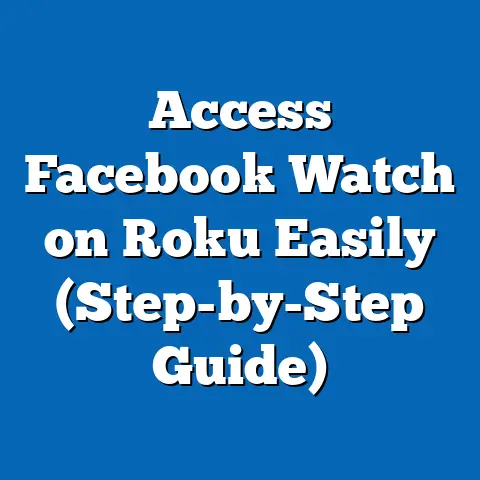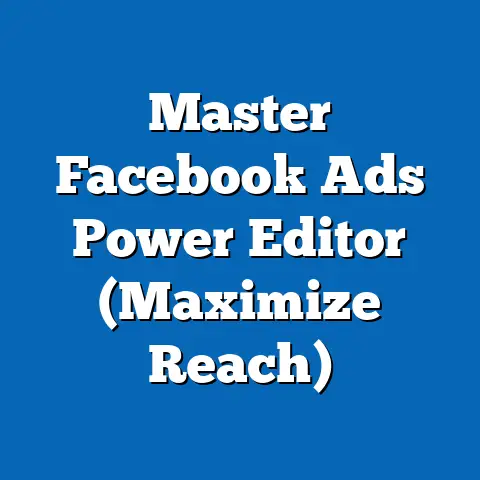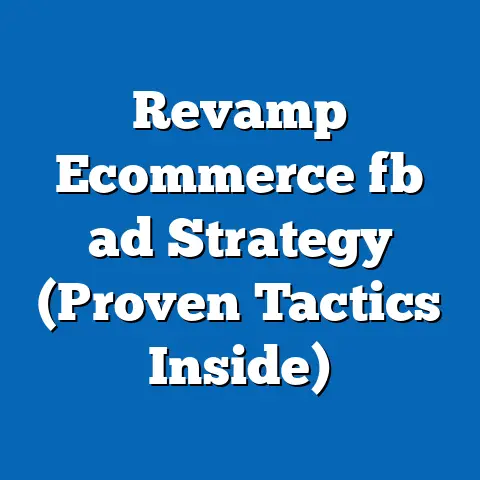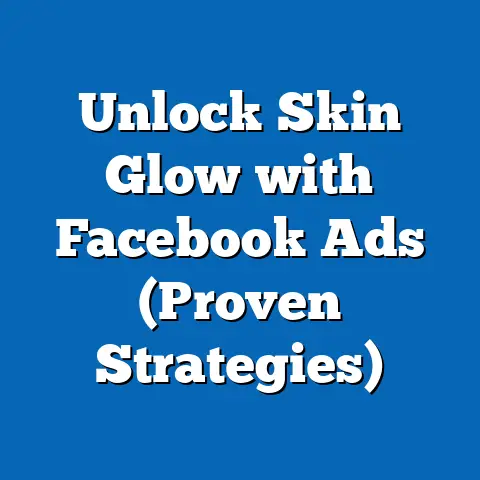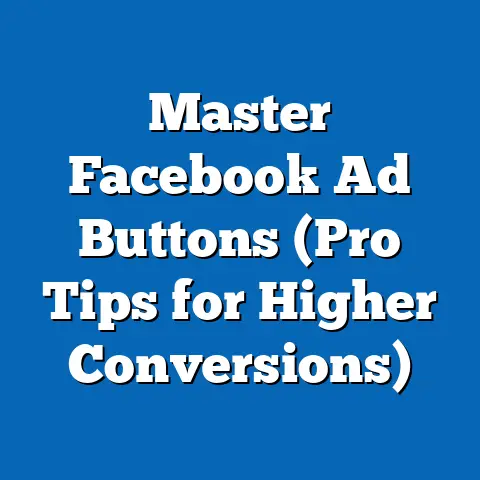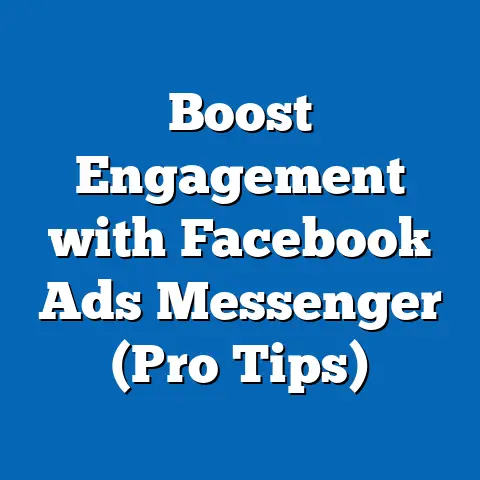Boost Product Sales with Facebook Ads (Proven Strategies)
I’ve seen firsthand how Facebook Ads can transform a business. It’s not just about throwing money at the platform; it’s about strategy, understanding your audience, and crafting compelling messages. In this article, I’m going to share proven strategies to help you boost product sales with Facebook Ads, all while keeping things simple and effective. Forget the complex jargon and overwhelming tactics. We’re focusing on what truly works.
Understanding Facebook Ads
Facebook Ads are a powerful tool that allows businesses to reach a massive audience with targeted messages. Think of it as your digital billboard, but instead of reaching everyone driving by, you’re reaching people who are actually interested in what you have to offer.
How They Work:
Facebook Ads operate on an auction system. You set your budget and bid for placements (where your ad appears). Facebook then decides which ads to show based on factors like your bid, ad quality, and relevance to the user.
Key Components:
- Campaign Objective: What do you want to achieve? (e.g., website traffic, sales, leads)
- Target Audience: Who are you trying to reach? (e.g., demographics, interests, behaviors)
- Ad Placement: Where will your ad be shown? (e.g., Facebook feed, Instagram feed, Messenger)
- Ad Creative: The visual and text of your ad.
- Budget and Bidding: How much are you willing to spend and how aggressively do you want to bid?
The Power of Audience Targeting:
This is where Facebook Ads truly shine. I’ve witnessed campaigns skyrocket simply by refining the targeting. Imagine selling handmade dog collars. Instead of just targeting “dog lovers,” you can target “dog owners who live in your city,” “people who have recently liked dog-related pages,” or even “people who have purchased dog products online in the past.” The more specific you are, the more likely you are to reach people who are ready to buy.
Ad Formats: A Quick Overview
- Image Ads: Simple and effective for showcasing your product.
- Video Ads: Great for telling a story or demonstrating your product in action.
- Carousel Ads: Allow you to showcase multiple products in a single ad.
- Collection Ads: Designed for mobile shopping, allowing users to browse and purchase products directly from the ad.
Takeaway: Facebook Ads offer incredible targeting capabilities and a variety of ad formats to reach your ideal customers. Understanding these basics is crucial for building successful campaigns.
Defining Your Goals
Before you even think about creating an ad, you need to know why you’re creating it. What do you want to achieve? Setting clear and measurable goals is the foundation of any successful Facebook Ads campaign.
Why Goals Matter:
- Direction: Goals provide a clear direction for your campaign.
- Measurement: Goals allow you to measure your success and track your progress.
- Optimization: Goals help you identify areas for improvement and optimize your campaigns.
Common Goals for Product Sales:
- Increase Website Traffic: Drive more visitors to your online store.
- Generate Leads: Collect contact information from potential customers.
- Boost Product Sales: The ultimate goal – increase your revenue.
- Increase Brand Awareness: Get your product in front of a wider audience.
Examples of Specific Goals:
- “Increase website traffic by 20% in the next month.”
- “Generate 50 leads for our new product line.”
- “Increase product sales by 15% in the next quarter.”
How Goals Shape Your Strategy:
Let’s say your goal is to increase product sales. Your ad copy might focus on special offers, discounts, or limited-time promotions. Your targeting might focus on customers who have previously purchased from you or who have shown interest in similar products.
On the other hand, if your goal is to increase brand awareness, your ad copy might focus on telling your brand story or highlighting your unique value proposition. Your targeting might focus on a broader audience.
My Experience: I once worked with a small business owner who was frustrated with their Facebook Ads results. After digging deeper, I realized they didn’t have clearly defined goals. They were simply “trying to sell more stuff.” Once we sat down and defined specific goals (e.g., “Increase sales of product X by 10% in the next month”), their campaigns became much more focused and effective.
Takeaway: Define your goals before you start creating your Facebook Ads. This will give your campaigns direction, allow you to measure your success, and help you optimize your results.
Crafting Compelling Ad Copy
Your ad copy is your chance to grab attention, pique interest, and persuade potential customers to take action. But in today’s fast-paced digital world, people have incredibly short attention spans. That’s why simplicity and clarity are key.
The Elements of Effective Ad Copy:
- Headline: The first thing people see. It needs to be attention-grabbing and relevant.
- Description: Provides more detail about your product and its benefits.
- Call to Action (CTA): Tells people what you want them to do (e.g., “Shop Now,” “Learn More,” “Sign Up”).
Writing Compelling Headlines:
- Use strong verbs: “Discover,” “Unlock,” “Transform.”
- Highlight benefits: “Get the best sleep of your life.”
- Create a sense of urgency: “Limited-time offer,” “Sale ends soon.”
- Ask a question: “Are you tired of [problem]?”
- Use numbers: “5 ways to [benefit].”
Persuasive Descriptions:
- Focus on benefits, not features: Instead of saying “This product has a powerful engine,” say “This product will save you time and money.”
- Use emotional language: “Feel confident,” “Experience the joy,” “Live your best life.”
- Tell a story: Connect with your audience on a personal level.
- Use social proof: Include testimonials or reviews.
Call to Action (CTA) Phrases That Drive Conversions:
- Shop Now: Direct and effective for driving sales.
- Learn More: Good for generating leads or educating your audience.
- Sign Up: Great for building your email list.
- Get Started: Encourages immediate action.
- Claim Your Offer: Creates a sense of exclusivity.
Example:
Let’s say you’re selling organic coffee beans. Here’s an example of effective ad copy:
- Headline: “Discover the Rich, Smooth Taste of Organic Coffee”
- Description: “Start your day with our ethically sourced, organic coffee beans. Experience the difference a premium cup can make. Shop now and get 10% off your first order!”
- CTA: “Shop Now”
My Tip: I always recommend testing different versions of your ad copy to see what resonates best with your audience. Experiment with different headlines, descriptions, and CTAs to optimize your results.
Takeaway: Crafting compelling ad copy is essential for grabbing attention and driving conversions. Keep it simple, focus on benefits, and use strong CTAs.
Designing Eye-Catching Visuals
In the world of Facebook Ads, visuals are king. People are scrolling through their feeds at lightning speed, so you need to grab their attention instantly. Your visuals are your first impression, and they need to be memorable, relevant, and visually appealing.
The Role of Visuals:
- Attract Attention: Stop the scroll and make people notice your ad.
- Enhance Message Delivery: Communicate your message quickly and effectively.
- Build Brand Recognition: Reinforce your brand identity.
Guidelines for Eye-Catching Images and Videos:
- High Quality: Use professional-looking images and videos.
- Relevant: Make sure your visuals are relevant to your product and your target audience.
- Visually Appealing: Use bright colors, interesting compositions, and compelling imagery.
- Mobile-Friendly: Optimize your visuals for mobile devices, as most Facebook users are on their phones.
Brand Consistency:
Your visuals should be consistent with your brand identity. Use the same colors, fonts, and imagery across all of your ads. This will help build brand recognition and trust with potential customers.
Tools and Resources:
- Canva: A user-friendly design tool for creating professional-looking graphics.
- Adobe Creative Cloud: A suite of professional design tools for more advanced users.
- Unsplash and Pexels: Websites offering free, high-quality stock photos.
Example:
If you’re selling fitness apparel, your visuals might include images of people wearing your apparel while working out. The images should be high-quality, visually appealing, and relevant to your target audience (e.g., active individuals who are passionate about fitness).
My Mistake: I once ran a campaign for a client that had amazing ad copy but terrible visuals. The images were blurry, low-resolution, and didn’t accurately represent the product. The campaign flopped. As soon as we updated the visuals with high-quality images, the campaign’s performance improved dramatically.
Takeaway: Invest in high-quality visuals that are relevant to your product and your target audience. Consistency is key when it comes to branding.
Targeting Your Audience
Targeting is the secret weapon of Facebook Ads. It allows you to reach the people who are most likely to be interested in your product, saving you time and money.
Facebook’s Targeting Options:
- Demographics: Age, gender, location, education, job title, etc.
- Interests: Hobbies, interests, and activities.
- Behaviors: Purchase behavior, device usage, travel habits, etc.
- Custom Audiences: Target people who have interacted with your business in the past (e.g., website visitors, email subscribers, customers).
- Lookalike Audiences: Find new people who are similar to your existing customers.
Custom Audiences:
This is where things get really powerful. You can upload a list of your existing customers (email addresses or phone numbers) and target them directly. You can also create custom audiences based on website visitors, app users, or people who have interacted with your Facebook page.
Lookalike Audiences:
Once you have a custom audience, you can create a lookalike audience. Facebook will analyze the characteristics of your custom audience and find new people who are similar. This is a great way to expand your reach and find new customers who are likely to be interested in your product.
Successful Targeting Strategies:
- Start broad, then narrow down: Begin with a broad audience and then refine your targeting based on the data you collect.
- Test different targeting options: Experiment with different combinations of demographics, interests, and behaviors to see what works best.
- Use layering: Combine multiple targeting options to create a highly targeted audience.
- Pay attention to your audience size: If your audience is too small, your ads may not be seen by enough people. If your audience is too large, your ads may be wasted on people who aren’t interested.
Example:
Let’s say you’re selling vegan protein powder. Your targeting might include:
- Demographics: Age 25-45, located in the United States, interested in health and fitness.
- Interests: Veganism, vegetarianism, plant-based diets, healthy eating.
- Behaviors: Purchase organic food, visit health and wellness websites.
- Custom Audience: Target people who have visited your website or signed up for your email list.
- Lookalike Audience: Find new people who are similar to your existing customers.
My Recommendation: Don’t underestimate the power of retargeting. I’ve seen incredible results from retargeting ads to people who have visited a product page but didn’t make a purchase. A simple ad reminding them of the product and offering a small discount can be incredibly effective.
Takeaway: Targeting is essential for reaching the right people with your Facebook Ads. Use Facebook’s targeting options to reach your ideal customers and maximize your ROI.
Budgeting and Bidding Strategies
Setting the right budget and choosing the right bidding strategy is crucial for maximizing your return on investment. You don’t want to overspend and waste money, but you also don’t want to underspend and miss out on potential sales.
Budgeting Basics:
- Daily Budget: The average amount you’re willing to spend per day.
- Lifetime Budget: The total amount you’re willing to spend over the entire duration of your campaign.
Choosing Between Daily and Lifetime Budgets:
- Daily Budget: Good for ongoing campaigns that you want to run consistently.
- Lifetime Budget: Good for campaigns with a specific start and end date (e.g., a limited-time promotion).
Bidding Strategies:
- Manual Bidding: You set the maximum amount you’re willing to pay per click or impression.
- Automatic Bidding: Facebook automatically sets your bids to get the most results for your budget.
Choosing the Right Bidding Strategy:
- Manual Bidding: Good for experienced advertisers who want more control over their bids.
- Automatic Bidding: Good for beginners or for campaigns where you want to let Facebook optimize your bids for you.
Monitoring and Adjusting Your Budget:
- Track your results: Monitor your key performance indicators (KPIs) to see how your ads are performing.
- Adjust your budget based on performance: If your ads are performing well, you may want to increase your budget. If your ads are not performing well, you may want to decrease your budget or try a different targeting strategy.
My Advice: Start small and scale up. Begin with a smaller budget and gradually increase it as you see positive results. This will help you minimize your risk and maximize your ROI.
Takeaway: Set a realistic budget and choose the right bidding strategy for your campaign goals. Monitor your results and adjust your budget as needed to optimize your ROI.
Analyzing and Optimizing Campaigns
Running Facebook Ads is not a “set it and forget it” activity. It requires ongoing analysis and optimization to ensure you’re getting the best possible results.
Tracking Key Performance Indicators (KPIs):
- Impressions: The number of times your ad was shown.
- Reach: The number of unique people who saw your ad.
- Clicks: The number of times people clicked on your ad.
- Click-Through Rate (CTR): The percentage of people who saw your ad and clicked on it.
- Cost Per Click (CPC): The average cost you paid for each click.
- Conversions: The number of people who took the desired action (e.g., made a purchase, signed up for your email list).
- Conversion Rate: The percentage of people who clicked on your ad and took the desired action.
- Return on Ad Spend (ROAS): The amount of revenue you generated for every dollar you spent on ads.
Tools and Metrics:
- Facebook Ads Manager: Facebook’s built-in tool for creating, managing, and analyzing your ads.
- Google Analytics: A web analytics tool that can help you track website traffic and conversions.
Optimizing Your Campaigns:
- A/B Testing: Test different versions of your ads to see what performs best.
- Adjusting Targeting: Refine your targeting based on the data you collect.
- Optimizing Creative Elements: Experiment with different headlines, descriptions, and visuals to see what resonates best with your audience.
- Refining Your Bidding Strategy: Adjust your bids based on your performance data.
- Analyzing Placement Performance: See where your ads are performing best (e.g., Facebook feed, Instagram feed) and allocate more budget to those placements.
Example:
Let’s say you’re running a Facebook Ads campaign to promote a new product. After a week, you notice that your CTR is low and your CPC is high. This could indicate that your ad copy or visuals aren’t compelling enough, or that your targeting is too broad. You could try A/B testing different headlines or visuals, or refining your targeting to reach a more specific audience.
A Real-World Success: I once helped a client increase their ROAS by 300% by simply focusing on A/B testing their ad creative. We tested different headlines, images, and CTAs until we found the combination that resonated best with their target audience.
Takeaway: Analyze your campaign data regularly and use the insights you gain to optimize your results. A/B testing is your best friend.
Conclusion
Boosting product sales with Facebook Ads doesn’t have to be complicated. By understanding the basics of Facebook Ads, defining your goals, crafting compelling ad copy, designing eye-catching visuals, targeting your audience, setting a realistic budget, and analyzing your campaigns, you can create effective campaigns that drive results.
Remember, simplicity is key. Focus on creating clear, concise, and compelling messages that resonate with your target audience. Don’t be afraid to experiment and test different strategies to see what works best for your business.
I encourage you to implement the strategies outlined in this article and monitor your own success. With a little effort and attention to detail, you can use Facebook Ads to significantly boost your product sales and grow your business. Good luck!

